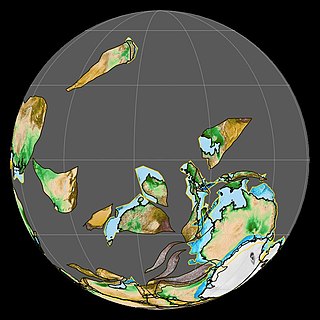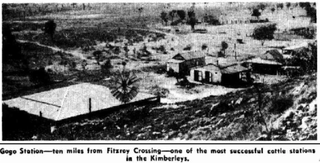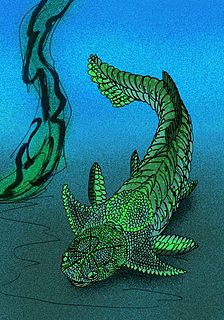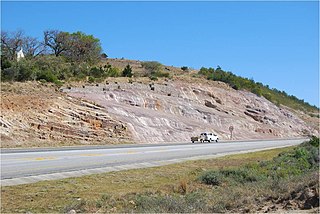
The Devonian is a geologic period and system of the Paleozoic, spanning 60.3 million years from the end of the Silurian, 419.2 million years ago (Mya), to the beginning of the Carboniferous, 358.9 Mya. It is named after Devon, England, where rocks from this period were first studied.

The Late Devonian extinction consisted of several extinction events in the Late Devonian Epoch, which collectively represent one of the five largest mass extinction events in the history of life on Earth. The term primarily refers to a major extinction, the Kellwasser event, which occurred around 372 million years ago, at the boundary between the Frasnian stage and the Famennian stage, the last stage in the Devonian Period. Overall, 19% of all families and 50% of all genera became extinct. A second mass extinction, the Hangenberg event, occurred 359 million years ago, bringing an end to the Famennian and Devonian, as the world transitioned into the Carboniferous Period.
The Givetian is one of two faunal stages in the Middle Devonian Period. It lasted from 387.7 million years ago to 382.7 million years ago. It was preceded by the Eifelian Stage and followed by the Frasnian Stage. It is named after the town of Givet in France. The oldest forests occurred during the late Givetian. The lower GSSP is located at Jebel Mech Irdane, Tafilalt, Morocco.

The zosterophylls are a group of extinct land plants that first appeared in the Silurian period. The taxon was first established by Banks in 1968 as the subdivision Zosterophyllophytina; they have since also been treated as the division Zosterophyllophyta or Zosterophyta and the class or plesion Zosterophyllopsida or Zosteropsida. They were among the first vascular plants in the fossil record, and had a world-wide distribution. They were probably stem-group lycophytes, forming a sister group to the ancestors of the living lycophytes. By the late Silurian a diverse assemblage of species existed, examples of which have been found fossilised in what is now Bathurst Island in Arctic Canada.

The Tournaisian is in the ICS geologic timescale the lowest stage or oldest age of the Mississippian, the oldest subsystem of the Carboniferous. The Tournaisian age lasted from 358.9 Ma to 346.7 Ma. It is preceded by the Famennian and is followed by the Viséan.

Groenlandaspis is an extinct genus of arthrodire from the Late Devonian. Fossils of the different species are found in late Devonian strata in all continents except eastern Asia. The generic name commemorates the fact that the first specimens of the type species (G.mirabilis) were found in Greenland.

The Early Devonian is the first of three epochs comprising the Devonian period, corresponding to the Lower Devonian series. It lasted from 419.2 ± 3.2 to 393.3 ± 1.2 and began with the Lochkovian Stage 419.2 ± 3.2 to 410.8 ± 1.2, which was followed by the Pragian from 410.8 ± 3.2 to 407.6 ± 1.2 and then by the Emsian, which lasted until the Middle Devonian began, 393.3± 1.2 million years ago. During this time, the first ammonoids appeared, descending from bactritoid nautiloids. Ammonoids during this time period were simple and differed little from their nautiloid counterparts. These ammonoids belong to the order Agoniatitida, which in later epochs evolved to new ammonoid orders, for example Goniatitida and Clymeniida. This class of cephalopod molluscs would dominate the marine fauna until the beginning of the Mesozoic Era.

Gogonasus was a lobe-finned fish known from three-dimensionally preserved 380-million-year-old fossils found from the Gogo Formation in Western Australia. It lived in the Late Devonian period, on what was once a 1,400-kilometre coral reef off the Kimberley coast surrounding the north-west of Australia. Gogonasus was a small fish reaching 30–40 cm (1 ft) in length.

Nematothallus is a form genus comprising cuticle-like fossils. Some of its constituents likely represent red algae, whereas others resemble lichens.
The Orcadian Basin is a sedimentary basin of Devonian age that formed mainly as a result of extensional tectonics in northeastern Scotland after the end of the Caledonian orogeny. During part of its history, the basin was filled by a lake now known as Lake Orcadie. In that lacustrine environment, a sequence of finely bedded sedimentary rocks was deposited, containing well-preserved fish fossils, with alternating layers of mudstone and coarse siltstone to very fine sandstone. These flagstones split easily along the bedding and have been used as building material for thousands of years. The deposits of the Orcadian Basin form part of the Old Red Sandstone (ORS). The lithostratigraphic terms lower, middle and upper ORS, however, do not necessarily match exactly with sediments of lower, middle and upper Devonian age, as the base of the ORS is now known to be in the Silurian and the top in the Carboniferous.

Polysporangiophytes, also called polysporangiates or formally Polysporangiophyta, are plants in which the spore-bearing generation (sporophyte) has branching stems (axes) that bear sporangia. The name literally means 'many sporangia plant'. The clade includes all land plants (embryophytes) except for the bryophytes whose sporophytes are normally unbranched, even if a few exceptional cases occur. While the definition is independent of the presence of vascular tissue, all living polysporangiophytes also have vascular tissue, i.e., are vascular plants or tracheophytes. Extinct polysporangiophytes are known that have no vascular tissue and so are not tracheophytes.
Spongiophyton was a thallose fossil of the early to mid-Devonian, which is notoriously difficult to classify.

The Gogo Formation in the Kimberley region of Western Australia is a Lagerstätte that exhibits exceptional preservation of a Devonian reef community. The formation is named after Gogo Station, a cattle station where outcrops appear and fossils are often collected from, as is nearby Fossil Downs Station.
The Devonian Harrell Formation is a mapped bedrock unit in Pennsylvania, Maryland, West Virginia, and Virginia.

The evolution of fish began about 530 million years ago during the Cambrian explosion. It was during this time that the early chordates developed the skull and the vertebral column, leading to the first craniates and vertebrates. The first fish lineages belong to the Agnatha, or jawless fish. Early examples include Haikouichthys. During the late Cambrian, eel-like jawless fish called the conodonts, and small mostly armoured fish known as ostracoderms, first appeared. Most jawless fish are now extinct; but the extant lampreys may approximate ancient pre-jawed fish. Lampreys belong to the Cyclostomata, which includes the extant hagfish, and this group may have split early on from other agnathans.

The subphylum Hexapoda comprises most species of arthropods and includes the insects as well as three much smaller groups of wingless arthropods: Collembola, Protura, and Diplura. The Collembola are very abundant in terrestrial environments. Hexapods are named for their most distinctive feature: a consolidated thorax with three pairs of legs. Most other arthropods have more than three pairs of legs. Most recent studies have recovered Hexapoda as a subgroup of Crustacea.

Antarctilamna is an extinct genus of Devonian shark originally exemplified by Antarctilamna prisca from South Eastern Australia and Antarctica. The latest occurring described species is Antarctilamna ultima from the Waterloo Farm lagerstätte in South Africa. Antarctilamna has robust ctenacanthid-like spines which lack a deep insertion area, and are borne in front of the first dorsal fin; in addition to distinctive diplodont teeth with small intermediate cusps. Antarctilamna-like spines, known from the Bunga Beds locality in Australia have been ascribed to A. prisca.
Icriodus is an extinct conodont genus in the family Gnathodontidae.

Actinolepis is an extinct genus of actinolepid placoderm from the Early Devonian. Four species are known: A. magna from Estonia, A. spinosa from Latvia, the type species A. tuberculata from New Zealand and A. zaikai from Belarus.

The Waterloo Farm lagerstätte is a Famennian lagerstätte in South Africa that constitutes the only known record of a near-polar Devonian coastal ecosystem.














